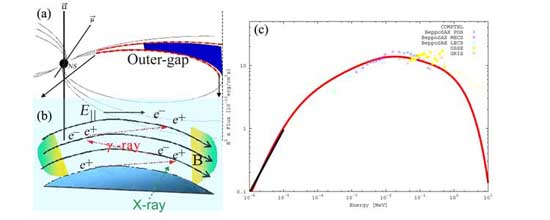Research Gallery > High Energy Astrophysics
Research Gallery
High Energy Astrophysics
| Outer gap model of the emission mechanism from neutron stars |
|
Image Credit: Takata et al.

Outer gap model of the emission mechanism from neutron stars (Takata et al, 2007, in press)
|
| A pulsar is a rapidly rotating (with about 0.1s period of rotation) and highly magnetized (~1012 Gauss) neutron star (NS). It is known that the pulsar is one of the brightest sources in the gamma-ray sky. We postulate that these gamma rays are produced by relativistic electrons and positrons accelerated by the electric fields parallel to the magnetic field lines in the outer gap region inside the pulsar's magnetosphere (Figure 1a). The gamma-ray photons then in turn produce new electrons and positrons via the pair-creation process. The observed photons are emitted by curvature radiation, synchrotron radiation and the inverse-Compton process (Figure 1b). The theoretical spectrum has been compared with the observed data for the Crab pulsar (Figure 1c), indicating that the outer-gap accelerator model appears to explain the observed data very well. |
 asiaa.sinica.edu.tw Media Request: epo
asiaa.sinica.edu.tw Media Request: epo asiaa.sinica.edu.tw
asiaa.sinica.edu.tw 